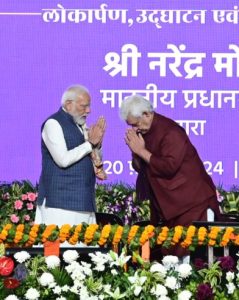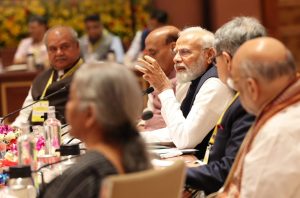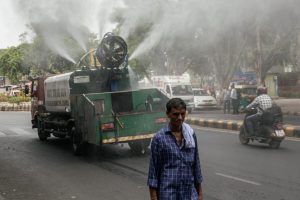India ducks 4-time more inflation, far higher fiscal deficit

Photo credit Twitter Nirmala Sitharaman
By Nancy Sharma
New Delhi, August 18: Comparison of the Covid-19 pandemic and the Global Financial Crisis (GFC) of 2008 makes an interesting case for the contrasting consequences of the action of India and the developed world.
If India had taken the same policy measures, as the advanced economies, or the ones undertaken during the GFC in 2008, there would have been four times as much inflation, two-and-a-half times more fiscal deficit, and India would have been a part of the fragile five economies.
When the world took a deep dent in the form of the novel coronavirus, production capacities and confidence with far-reaching economic and social costs, the government of India imposed a strict lockdown in March 2020 given the severity of the pandemic.
The quarantined Indian economy contracted by 7.3 per cent in 2020-21, the worst decline since 1996 as the economy remained shuttered except for some essential services and activities. In addition, the supply chain disruptions, restrained workforce participation, risks from new variants of the virus and the Russia-Ukraine war have emerged as dampeners to the global growth outlook and India is no exception.
To mitigate the negative impact of the pandemic, the Central government announced the ‘Aatma Nirbhar Bharat Package (ANBP)’, a special economic and comprehensive package of Rs 20 lakh crores – equivalent to 10 per cent of India’s GDP to encourage business, attract investments and strengthen the resolve for ‘Make in India’.
Despite the unprecedented challenges faced across the globe, India stood strong with higher GDP growth (8.7 per cent) relative to the other developed countries. Also, the success of India’s vaccination programme helped in the effective containment of the highly infectious virus. India not only recovered to the pre-pandemic levels quickly but supported the supply of medicines to over 150 countries besides the Covid-19 vaccine supply to over 101 nations.
Going back in time, post the Economic reforms of 1991, India’s ties with the global economy deepened, resulting in a more than doubled merchandise trade from hardly 15 per cent in 1990-91 to 36 per cent in 2007-08 while the invisible trade witnessed a four-fold increase to 19 per cent of the GDP.
Global integration made India vulnerable to the spillover effect of the Global Financial Crisis (GFC) of 2008.
In January 2008, the Indian stock market took the first hit of the GFC through the reversal of inflows from Foreign Institutional Investors (FIIs) which stood at USD 17.7 billion in 2007, leading to disinvestment in the following year.
Another hit was taken by the rupee as it tumbled by nearly 20 per cent and the bolstering measures led to the depletion of the foreign reserves.
The crisis then moved to the Indian money market adding pressure on the domestic banks and pushing the economy towards a liquidity crisis.
It further spread to the domestic credit market followed by negative growth in exports, industrial output, and central tax revenue collection, deteriorating the real economy coupled with rising inflation.
To cushion the spillovers, the Central government announced three fiscal stimulus packages commencing with across-the-board central excise duty reduction by 4 per cent points; additional plan spending of Rs 200 billion; additional borrowing by state governments of Rs 300 billion for plan expenditure; assistance to certain export industries in the form of interest subsidy on export finance, refund of excise duties/central sales tax, and other export incentives; and a 2 per cent -point reduction in central excise and service tax.

These fiscal packages amounted to 1.8 per cent of the Gross Domestic Product (GDP). Also, the Union budget 2008-09 reflected a low fiscal deficit of 2.5 per cent of GDP.
However, the actual deficit turned out to be around 11 per cent due to the debt waiver scheme for farmers, salary hikes for the government staff, additional expenditure on rural employment schemes, duty reductions for petroleum products and revenue shortfalls due to a slowdown in the economy.
Consequently, the GDP contracted to 5.8 per cent from 7.8%, meanwhile the government consumption reflected an upward trajectory to 35.9 per cent from 0.9 per cent in 2007-08.
Therefore, both the events and the corrective fiscal measures undertaken, India performed better in times of pandemic.
It is noteworthy that GDP contraction and inflation were higher in 2008, even though the economic activities were not shut down.
However, despite months of complete lockdowns, supply chain disruptions and the impact of the Ukraine-Russian war, India emerged with a rapid recovery growth rate with its commendable agile response.
Moreover, India is committed to meeting its global targets, including living up to its climate mitigation promises. In its Nationally Determined Contributions (NDCs) made at COP 21, India pledged to get 40 per cent of its installed electrical capacity from non-fossil sources by the year 2030, which has been met in November 2021.
(Views expressed solely belong to the author, who is a researcher with Public Policy Research Centre)








